- Home
- Oliver Sacks
Uncle Tungsten
Uncle Tungsten Read online
Oliver Sacks
Uncle Tungsten
Memories of a Chemical Boyhood
2001
Long before Oliver Sacks became a distinguished neurologist and bestselling writer, he was a small English boy fascinated by metals – also by chemical reactions (the louder and smellier the better), photography, squids and cuttlefish, H.G. Wells, and the periodic table. In this endlessly charming and eloquent memoir, the author of The Man Who Mistook His Wife for a Hat and Awakenings chronicles his love affair with science and the magnificently odd and sometimes harrowing childhood in which that love affair unfolded.
In Uncle Tungsten we meet Sacks’ extraordinary family, from his surgeon mother (who introduces the fourteen-year-old Oliver to the art of human dissection) and his father, a family doctor who imbues in his son an early enthusiasm for housecalls, to his ‘Uncle Tungsten,’ whose factory produces tungsten-filament lightbulbs. We follow the young Oliver as he is exiled at the age of six to a grim, sadistic boarding school to escape the London Blitz, and later watch as he sets about passionately reliving the exploits of his chemical heroes – in his own home laboratory. Uncle Tungsten is a crystalline view of a brilliant young mind springing to life, a story of growing up which is by turns elegiac, comic, and wistful, full of the electrifying joy of discovery.
CHAPTER ONE
Uncle Tungsten
Many of my childhood memories are of metals: these seemed to exert a power on me from the start. They stood out, conspicuous against the heterogeneousness of the world, by their shining, gleaming quality, their silveriness, their smoothness and weight. They seemed cool to the touch, and they rang when they were struck.
I loved the yellowness, the heaviness, of gold. My mother would take the wedding ring from her finger and let me handle it for a while, as she told me of its inviolacy, how it never tarnished. ‘Feel how heavy it is,’ she would add. ‘It’s even heavier than lead.’ I knew what lead was, for I had handled the heavy, soft piping the plumber had left one year. Gold was soft, too, my mother told me, so it was usually combined with another metal to make it harder.
It was the same with copper – people mixed it with tin to produce bronze. Bronze! – the very word was like a trumpet to me, for battle was the brave clash of bronze upon bronze, bronze spears on bronze shields, the great shield of Achilles. Or you could alloy copper with zinc, my mother said, to produce brass. All of us – my mother, my brothers, and I – had our own brass menorahs for Hanukkah. (My father had a silver one.)
I knew copper, the shiny rose color of the great copper cauldron in our kitchen – it was taken down only once a year, when the quinces and crab apples were ripe in the garden and my mother would stew them to make jelly.
I knew zinc: the dull, slightly bluish birdbath in the garden was made of zinc; and tin, from the heavy tinfoil in which sandwiches were wrapped for a picnic. My mother showed me that when tin or zinc was bent it uttered a special ‘cry’. ‘It’s due to deformation of the crystal structure,’ she said, forgetting that I was five, and could not understand her – and yet her words fascinated me, made me want to know more.
There was an enormous cast-iron lawn roller out in the garden – it weighed five hundred pounds, my father said. We, as children, could hardly budge it, but he was immensely strong and could lift it off the ground. It was always slightly rusty, and this bothered me, for the rust flaked off, leaving little cavities and scabs, and I was afraid the whole roller might corrode and fall apart one day, reduced to a mass of red dust and flakes. I needed to think of metals as stable, like gold – able to stave off the losses and ravages of time.
I would sometimes beg my mother to take out her engagement ring and show me the diamond in it. It flashed like nothing I had ever seen, almost as if it gave out more light than it took in. She would show me how easily it scratched glass, and then tell me to put it to my lips. It was strangely, startlingly cold; metals felt cool to the touch, but the diamond was icy. That was because it conducted heat so well, she said – better than any metal – so it drew the body heat away from one’s lips when they touched it. This was a feeling I was never to forget. Another time, she showed me how if one touched a diamond to a cube of ice, it would draw heat from one’s hand into the ice and cut straight through it as if it were butter. My mother told me that diamond was a special form of carbon, like the coal we used in every room in winter. I was puzzled by this – how could black, flaky, opaque coal be the same as the hard, transparent gemstone in her ring?
I loved light, especially the lighting of the shabbas candles on Friday nights, when my mother would murmur a prayer as she lit them. I was not allowed to touch them once they were lit – they were sacred, I was told, their flames were holy, not to be fiddled with. I was mesmerized by the little cone of blue flame at the candle’s center – why was it blue? Our house had coal fires, and I would often gaze into the heart of a fire, watching it go from a dim red glow to orange, to yellow, and then I would blow on it with the bellows until it glowed almost white-hot. If it got hot enough, I wondered, would it blaze blue, be blue-hot?
Did the sun and stars burn in the same way? Why did they never go out? What were they made of? I was reassured when I learned that the core of the earth consisted of a great ball of iron – this sounded solid, something one could depend on. And I was pleased when I was told that we ourselves were made of the very same elements as composed the sun and stars, that some of my atoms might once have been in a distant star. But it frightened me too, made me feel that my atoms were only on loan and might fly apart at any time, fly away like the fine talcum powder I saw in the bathroom.
I badgered my parents constantly with questions. Where did color come from? Why did my mother use the platinum loop that hung above the stove to cause the gas burner to catch fire? What happened to the sugar when one stirred it into the tea? Where did it go? Why did water bubble when it boiled? (I liked to watch water set to boil on the stove, to see it quivering with heat before it burst into bubbles.)
My mother showed me other wonders. She had a necklace of polished yellow pieces of amber, and she showed me how, when she rubbed them, tiny pieces of paper would fly up and stick to them. Or she would put the electrified amber against my ear, and I would hear and feel a tiny snap, a spark.
My two older brothers Marcus and David, nine and ten years older than I, were fond of magnets and enjoyed demonstrating these to me, drawing the magnet beneath a piece of paper on which were strewn powdery iron filings. I never tired of the remarkable patterns that rayed out from the poles of the magnet. ‘Those are lines of force,’ Marcus explained to me – but I was none the wiser.
Then there was the crystal radio my brother Michael gave me, which I played with in bed, jiggling the wire on the crystal until I got a station loud and clear. And the luminous clocks – the house was full of them, because my uncle Abe had been a pioneer in the development of luminous paints. These, too, like my crystal radio, I would take under the bedclothes at night, into my private, secret vault, and they would light up my cavern of sheets with an eerie, greenish light.
All these things – the rubbed amber, the magnets, the crystal radio, the clock dials with their tireless coruscations – gave me a sense of invisible rays and forces, a sense that beneath the familiar, visible world of colors and appearances there lay a dark, hidden world of mysterious laws and phenomena.
Whenever we had ‘a fuse,’ my father would climb up to the porcelain fusebox high on the kitchen wall, identify the fused fuse, now reduced to a melted blob, and replace it with a new fuse of an odd, soft wire. It was difficult to imagine that a metal could melt – could a fuse really be made from the same material as a lawn roller or a tin can?
The fuses were made of a special alloy, my father
told me, a combination of tin and lead and other metals. All of these had relatively low melting points, but the melting point of their alloy was lower still. How could this be so, I wondered? What was the secret of this new metal’s strangely low melting point?
For that matter, what was electricity, and how did it flow? Was it a sort of fluid like heat, which could also be conducted? Why did it flow through the metal but not the porcelain? This, too, called for explanation.
My questions were endless, and touched on everything, though they tended to circle around, again and again, to my obsession, the metals. Why were they shiny? Why smooth? Why cool? Why hard? Why heavy? Why did they bend, not break? Why did they ring? Why could two soft metals like zinc and copper, or tin and copper, combine to produce a harder metal? What gave gold its goldness, and why did it never tarnish? My mother was patient, for the most part, and tried to explain, but eventually, when I exhausted her patience, she would say, ‘That’s all I can tell you – you’ll have to quiz Uncle Dave to learn more.’
We had called him Uncle Tungsten for as long as I could remember, because he manufactured lightbulbs with filaments of fine tungsten wire. His firm was called Tungstalite, and I often visited him in the old factory in Farringdon and watched him at work, in a wing collar, with his shirtsleeves rolled up. The heavy, dark tungsten powder would be pressed, hammered, sintered at red heat, then drawn into finer and finer wire for the filaments. Uncle’s hands were seamed with the black powder, beyond the power of any washing to get out (he would have to have the whole thickness of epidermis removed, and even this, one suspected, would not have been enough). After thirty years of working with tungsten, I imagined, the heavy element was in his lungs and bones, in every vessel and viscus, every tissue of his body. I thought of this as a wonder, not a curse – his body invigorated and fortified by the mighty element, given a strength and enduringness almost more than human.
Whenever I visited the factory, he would take me around the machines, or have his foreman do so. (The foreman was a short, muscular man, a Popeye with enormous forearms, a palpable testament to the benefits of working with tungsten.) I never tired of the ingenious machines, always beautifully clean and sleek and oiled, or the furnace where the black powder was compacted from a powdery incoherence into dense, hard bars with a grey sheen.
During my visits to the factory, and sometimes at home, Uncle Dave would teach me about metals with little experiments. I knew that mercury, that strange liquid metal, was incredibly heavy and dense. Even lead floated on it, as my uncle showed me by floating a lead bullet in a bowl of quicksilver. But then he pulled out a small grey bar from his pocket, and to my amazement, this sank immediately to the bottom. That, he said, was his metal, tungsten.
Uncle loved the density of the tungsten he made, and its refractoriness, its great chemical stability. He loved to handle it – the wire, the powder, but the massy little bars and ingots most of all. He caressed them, balanced them (tenderly, it seemed to me) in his hands. ‘Feel it, Oliver,’ he would say, thrusting a bar at me. ‘Nothing in the world feels like sintered tungsten.’ He would tap the little bars and they would emit a deep clink. ‘The sound of tungsten,’ Uncle Dave would say, ‘nothing like it.’ I did not know whether this was true, but I never questioned it.
As the youngest of almost the youngest (I was the last of four, and my mother the sixteenth of eighteen), I was born almost a hundred years after my maternal grandfather and never knew him. He was born Mordechai Fredkin, in 1837, in a small village in Russia. As a youth he managed to avoid being impressed into the Cossack army and fled Russia using the passport of a dead man named Landau; he was just sixteen. As Marcus Landau, he made his way to Paris and then Frankfurt, where he married (his wife was sixteen too).Two years later, in 1855, now with the first of their children, they moved to England.
My mother’s father was, by all accounts, a man drawn equally to the spiritual and the physical. He was by profession a boot and shoe manufacturer, a shochet (a kosher slaughterer), and later a grocer – but he was also a Hebrew scholar, a mystic, an amateur mathematician, and an inventor. He had a wide-ranging mind: he published a newspaper, the Jewish Standard, in his basement, from 1888 to 1891; he was interested in the new science of aeronautics and corresponded with the Wright brothers, who paid him a visit when they came to London in the early 1900s (some of my uncles could still remember this). He had a passion, my aunts and uncles told me, for intricate arithmetical calculations, which he would do in his head while lying in the bath. But he was drawn above all to the invention of lamps – safety lamps for mines, carriage lamps, streetlamps – and he patented many of these in the 1870s.
A polymath and autodidact himself, Grandfather was passionately keen on education – and, most especially, a scientific education – for all his children, for his nine daughters no less than his nine sons. Whether it was this or the sharing of his own passionate enthusiasms, seven of his sons were eventually drawn to mathematics and the physical sciences, as he was. His daughters, by contrast, were by and large drawn to the human sciences – to biology, to medicine, to education and sociology. Two of them founded schools. Two others were teachers. My mother was at first torn between the physical and the human sciences: she was particularly attracted to chemistry as a girl (her older brother Mick had just begun a career as a chemist), but later became an anatomist and surgeon. She never lost her love of, her feeling for, the physical sciences, nor the desire to go beneath the surfaces of things, to explain. Thus the thousand and one questions I asked as a child were seldom met by impatient or peremptory answers, but careful ones which enthralled me (though they were often above my head). I was encouraged from the start to interrogate, to investigate.
Given all my aunts and uncles (and a couple more on my father’s side), my cousins numbered almost a hundred; and since the family, for the most part, was centered in London (though there were far-flung American, Continental, and South African branches), we would all meet frequently, tribally, on family occasions. This sense of extended family was one I knew and enjoyed as far back as memory goes, and it went with a sense that it was our business, the family business, to ask questions, to be ‘scientific,’ just as we were Jewish or English. I was among the youngest of the cousins – I had cousins in South Africa who were forty-five years my senior – and some of these cousins were already practicing scientists or mathematicians; others, only a little older than myself, were already in love with science. One cousin was a young physics teacher; three were reading chemistry at university; and one, a precocious fifteen-year-old, was showing great mathematical promise. All of us, I could not help imagining, had a bit of the old man in us.
CHAPTER TWO
‘37’
I grew up just before the Second World War in a huge, rambling Edwardian house in northwest London. Being a corner house, at the junction of Mapesbury and Exeter Roads, number 37 Mapesbury Road faced onto both, and was larger than its neighbors. The house was basically square, almost cubical, but with a front porch that jutted out, V-shaped at the top, like the entry to a church. There were bow windows that also protruded on each side, with recesses in between, and thus the roof had a most complex shape, resembling, to my eyes, nothing so much as a giant crystal. The house was built of red brick of a peculiarly soft, dusky color. I imagined this, after I learned some geology, as being old red sandstone from the Devonian age, a thought encouraged by the fact that all the roads around us – Exeter, Teignmouth, Dartmouth, Dawlish – themselves had Devonian names.
There were double front doors, with a little vestibule between them, and these led onto a hall, and thence to a passage that led back toward the kitchen; the hall and the passage had a floor of tesselated colored stones. To the right of the hall, as one entered, the staircase curved upward, its heavy bannister polished smooth by my brothers sliding down it.
Certain rooms in the house had a magical or sacred quality, perhaps my parents’ surgery (both of them were physicians) above all, with its
bottles of medicine, its balance for weighing out powders, the racks of test tubes and beakers, the spirit lamp, and the examining table. There were all sorts of medicines, lotions, and elixirs in a large cabinet – it looked like an old-fashioned chemist’s shop in miniature – there was a microscope, and bottles of reagents for testing patients’ urine, like the bright blue Fehling’s solution, which turned yellow when there was sugar in the urine.
It was from this special room, where patients were admitted, but not (unless the door was left unlocked) my childish self, that I sometimes saw a glow of violet light coming out under the door and smelled a strange, seaside smell, which I later learned was ozone – this was the old ultraviolet lamp at work. I was not too sure, as a child, what doctors ‘did,’ and glimpses of catheters and bougies in their kidney dishes, retractors and speculums, rubber gloves, catgut thread and forceps – all this, I think, rather frightened me, though it fascinated me too. Once, when the door was left accidentally open, I saw a patient with her legs up in stirrups (in what I later learned was the ‘lithotomy position’). My mother’s obstetric bag and anesthetic bag were always ready to be grabbed in an emergency, and I knew when they would be needed, for I would hear comments like, ‘She’s half-a-crown dilated’ – comments which by their unintelligibility and mysterious-ness (were they a sort of code?) stimulated my imagination in all sorts of ways.
Another sacred room was the library, which, in the evenings at least, was especially my father’s domain. One section of the library wall was covered with his Hebrew books, but there were books on every subject – my mother’s books (she was fond of novels and biographies), my brothers’ books, and books inherited from grandparents. One bookcase was entirely devoted to plays – my parents, who had met as fellow enthusiasts in a medical students’ Ibsen society, still went to the theater every Thursday.

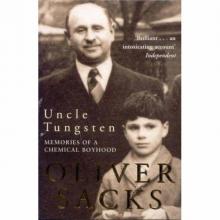 Uncle Tungsten
Uncle Tungsten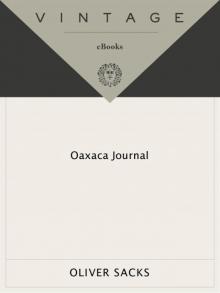 Oaxaca Journal
Oaxaca Journal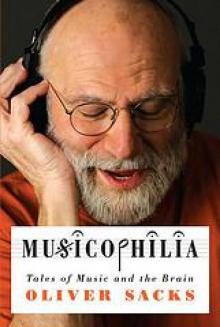 Musicophilia
Musicophilia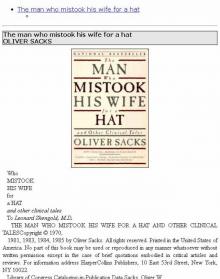 The man who mistook his wife for a hat
The man who mistook his wife for a hat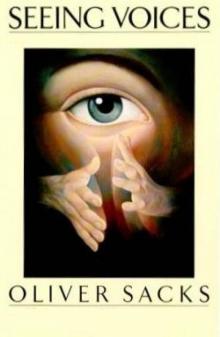 1989 - Seeing Voices
1989 - Seeing Voices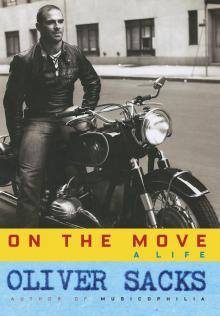 On the Move: A Life
On the Move: A Life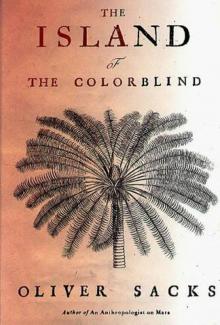 1996 - The Island of the Colorblind
1996 - The Island of the Colorblind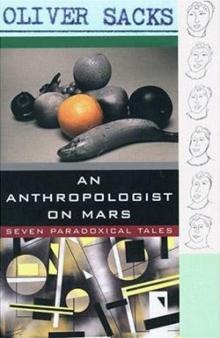 An Anthropologist on Mars: Seven Paradoxical Tales
An Anthropologist on Mars: Seven Paradoxical Tales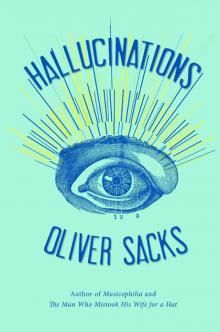 Hallucinations
Hallucinations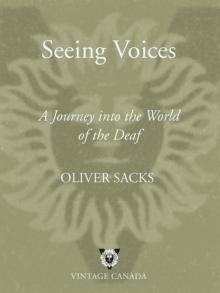 Seeing Voices
Seeing Voices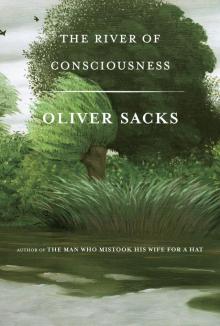 The River of Consciousness
The River of Consciousness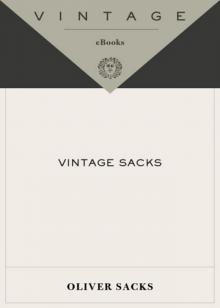 Vintage Sacks
Vintage Sacks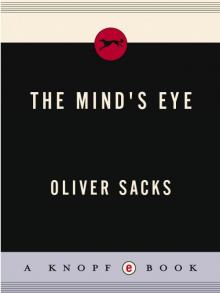 The Mind's Eye
The Mind's Eye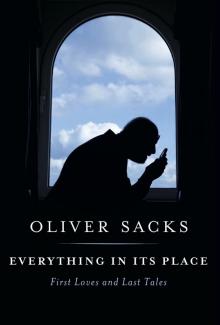 Everything in Its Place
Everything in Its Place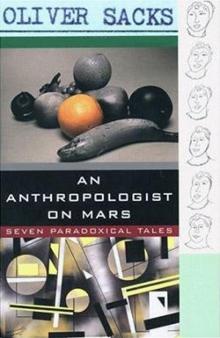 An Anthropologist on Mars (1995)
An Anthropologist on Mars (1995)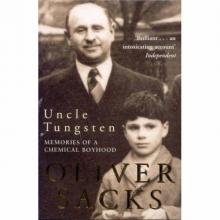 Uncle Tungsten: Memories of a Chemical Boyhood (2001)
Uncle Tungsten: Memories of a Chemical Boyhood (2001)